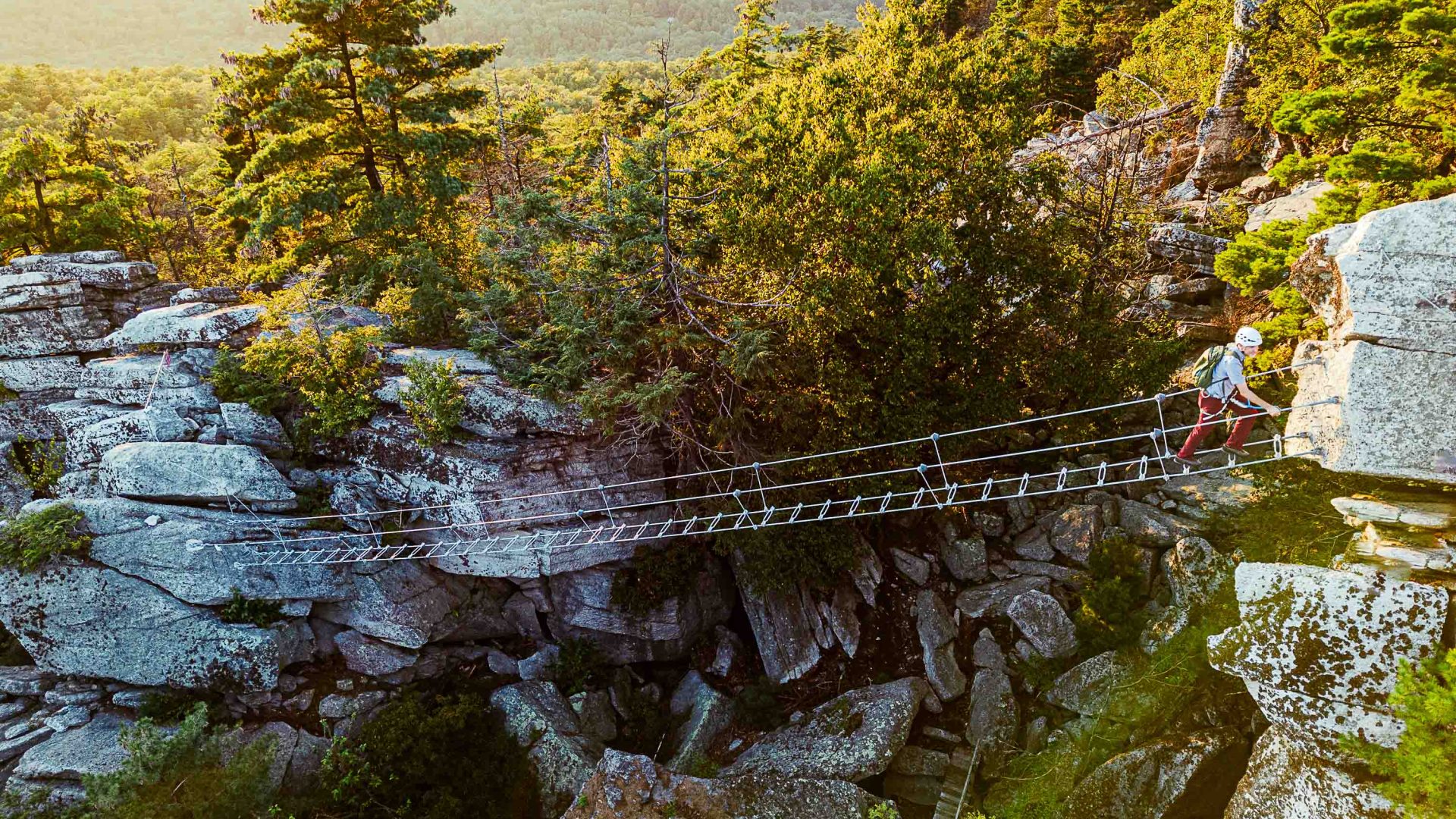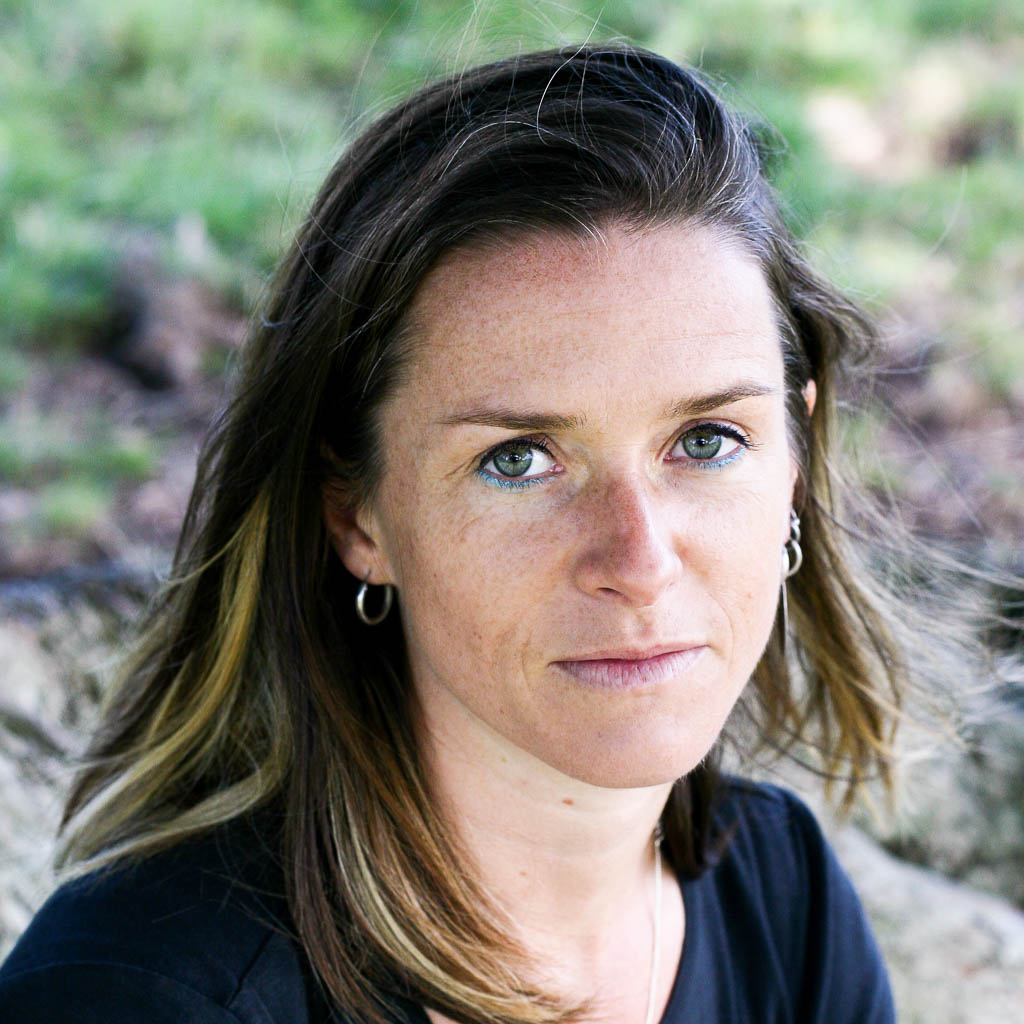
This European WWI-era mode of traversing mountains is becoming more and more popular in North America. But why? Writer and climber Amelia Arvesen investigates.


This European WWI-era mode of traversing mountains is becoming more and more popular in North America. But why? Writer and climber Amelia Arvesen investigates.
My gloved hands grip an iron rung, as my feet balance on another below. I’m perched 100 feet in the air, beneath a cliff edge in Upstate New York’s Shawangunk Mountains. There’s nothing between me and the rocky ground except a polyester sling attaching my harness to a steel cable. I don’t expect I’ll fall—I’m a climber and I’ve completed two via ferratas before—but still, my amygdala is triggering adrenaline and cortisol to pump through my body.
But I’m not alone up here, I’m with six other climbers and two guides, inching our way across one of the newest via ferrata courses in North America. The route opened this spring at Mohonk Mountain House, a 155-year-old Victorian castle resort surrounded by forest and involves sliding our slings along cables and wiggling our way around mountain ledges in single file.
Whenever we reach a treacherous part—the very wobbly suspension bridge being one—we shout encouraging words and affirmations that calm all our nerves. Despite our range in climbing experience, together we make it to the end where we’re treated to a storybook view of the gem-blue Mohonk Lake and the Hudson Valley beyond.

There’s something about the via ferrata course that bonds seven strangers in a way I haven’t experienced before, even in other outdoor activities like skiing and rock climbing. On the ridge, and on any via ferrata, you can’t move forward until the person in front of you has progressed. And you always—always—help the person behind you if they need it. A successful via ferrata journey is a combined effort, not a solo endeavor.
“There’s a leveling that happens out there,” says Reed Rowley, partner and development director for Colorado-based company Via Ferrata Works, one of the leaders in building new via ferrata courses across North America. “You can be a great athlete or you can be more of an amateur, and you can complete this course together and work as a team to get through it.”
The nuance of the conversations while you’re eating a granola bar looking out over a vista or putting on your equipment together or candidly sharing your experience—that still takes real world interaction… It’s the panacea we need as a society.
- Reed Rowley, Via Ferrata Works
The first via ferratas—Italian for ‘iron path’—were built in 1800s Europe as utilitarian connections between alpine villages and pastures. These routes became more prominent during WWI when Italian Army foot soldiers used the fixed cables, rungs, and ladders to move safely and efficiently through the Alps.
In the 1930s, the Italian Alpine Club restored the wartime networks as recreational attractions for tourists. The global climbing boom of the 1950s stoked even more interest in the mountain passages. And today, thousands of recreational via ferratas exist around the world, most notably in Italy, Austria, and France. But it took until the 2000s for them to emerge across the Atlantic.
Only a few routes existed at first, and those routes had to be built on private land as The Wilderness Act of 1964 bans the installation of permanent climbing anchors on public property. The first via ferrata course in the US arose in Kentucky’s Red River Gorge in 2001, followed by West Virginia’s Nelson Rocks in 2002 and Telluride, Colorado’s path in 2007.
In the last five years, two dozen new via ferratas have opened across North America offering more opportunity for a shared outdoor experience. Many can be found at ski areas and resorts like Mohonk; Mammoth Mountain and Tahoe, California; Jackson Hole, Wyoming; Taos Ski Valley, New Mexico; Zion, Utah; Golden, British Columbia, and Estes Park and Ouray, Colorado.
And more recently, via ferratas are cropping up in less expected places, expanding access and possibilities that transcend recreation. In 2022, the city of Columbus, Ohio hired Via Ferrata Works to build an 800-foot route in an abandoned rock quarry right outside town, making it the country’s first urban via ferrata. And this year, the University of Denver became the first-known educational institution in the world to install not one, but two, routes at their mountain campus in northern Colorado.
One day in June on the via ferrata, the campus hosted a group of students enrolled in an interdisciplinary program of ecology, botany, and film studies. “It was so cool to see a botanist student geeking out over a flower, and then a film student being like, ‘How do we shoot it?’” says Matt Jensen, director of The Outdoor Experience at the university’s mountain campus.
Similarly, when a fraternity visited, bravado faded to vulnerability as they traversed The Cirque route, which is the longest and steepest pitch in Colorado. “They came back totally humbled,” Jensen says, adding that the experience led the fraternity to an open conversation about their fears.
Research shows that group experiences such as on a via ferrata or other types of outdoor adventure can impact our behaviors and reshape the way we interact with others. A 2016 study by researchers at North-West University in South Africa found that outdoor adventure education can help us develop and hone our ‘soft skills,’ such as working in groups and problem-solving.
With most of our daily interactions happening through a screen, adventuring as a group can be an antidote to our isolation.
When I ask Rowley why he thinks these courses are only now gaining popularity in North America, he lands on a desire for connection.
“The value proposition is in building relationships and trust and community,” Rowley says. “The nuance of the conversations while you’re eating a granola bar looking out over a vista or putting on your equipment together or candidly sharing your experience—that still takes real world interaction… It’s the panacea we need as a society.”
With most of our daily interactions happening through a screen, adventuring as a group can be an antidote to our own isolation. I felt that magical connection with my group out there on the cliff in the Gunks, and back when I did the Telluride via ferrata, and again on the course at Kicking Horse Mountain Resort. For a start, when you’re on a via ferrata, your hands are too occupied to pull out your phone. Instead, you’re fully present trying to solve your way through a mountain puzzle with a group of strangers that are fast becoming friends.
In Mohonk when one of the women struggled on an overhung section and then made it through, we celebrated with her. When I didn’t know where to put my hand, my teammate pointed to the rung she had used. And yeah, maybe I could’ve gotten through the course without any help, but it wouldn’t have been half as fun or anywhere near as meaningful.
****
Adventure.com strives to be a low-emissions travel publication. We are powered by, but editorially independent of, Intrepid Travel, the world’s largest travel B Corp, who help ensure Adventure.com maintains high standards of sustainability in our work and activities. You can visit our sustainability page or read our Contributor Impact Guidelines for more information.

Amelia Arvesen is a Portland, Oregon-based journalist, the creator of Honing Her Craft, and an organizer with Empowerment Avenue, a group advocating for incarcerated writers and artists. She has a special interest in outdoor businesses, sustainable travel, and criminal justice reform. Her latest work appears in Outside, Backpacker, Men's Journal, and Via Magazine.






Can't find what you're looking for? Try using these tags: